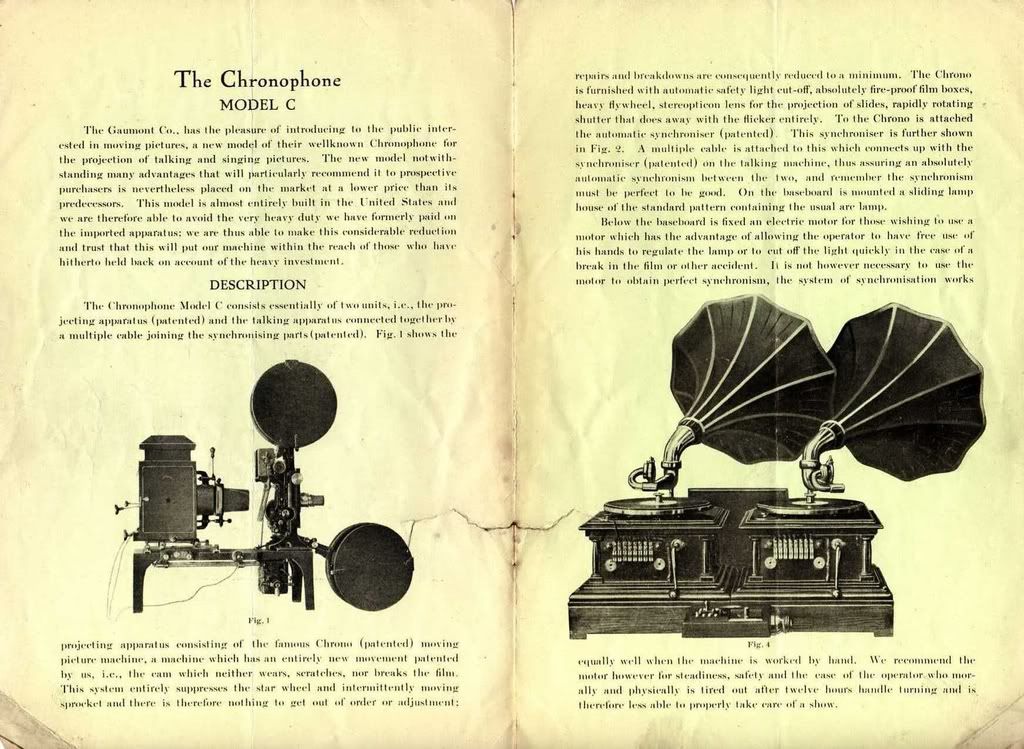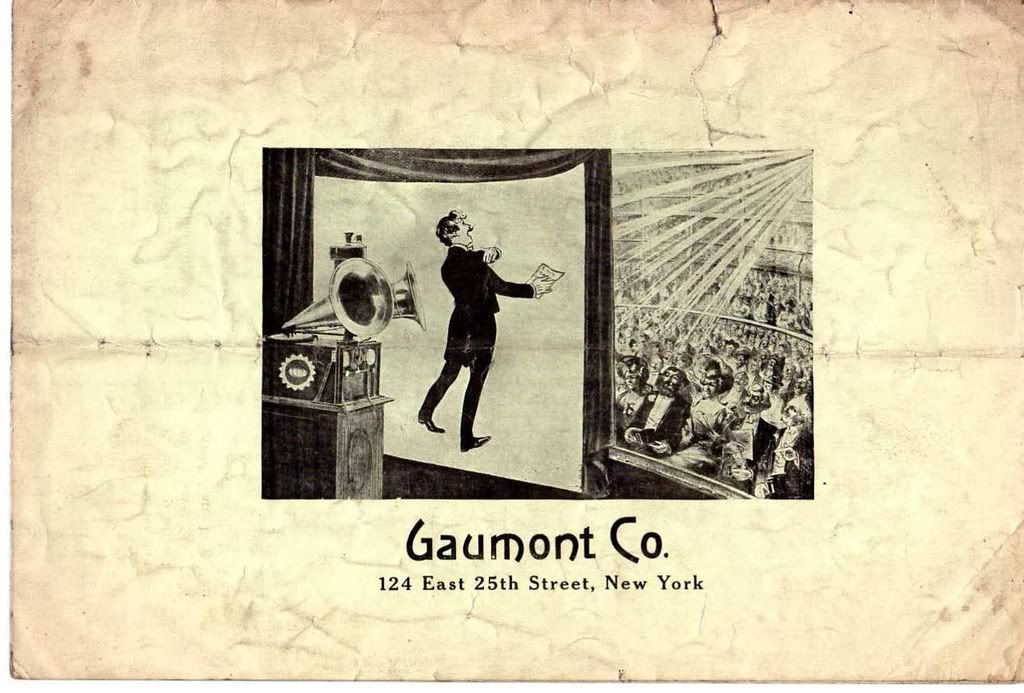Starkton
Two Spring Motor
  How do you get that
How do you get that
Posts: 61
|
Post by Starkton on Feb 2, 2009 18:17:19 GMT -6
I begin with a scarce disc of The Gaumont Company, Cleveland. Starting in 1907, this company demonstrated short films on Chronophones (accompanied by phonographs) in the US and Canada, at first especially with Vaudeville artists. This very early Gaumont variety is pasted over a green Zonophone label. British comedian Arthur Gilbert is heard with a typical song, recorded in 1906. Gilbert staged as artist for Leon Gaumont and at the same time held the position as director of Chronophone Films, Gaumont's production company.  |
|
|
|
Post by catfishjohn on Feb 2, 2009 18:39:31 GMT -6
Interesting...I knew sound in conjuntion with early films was attempted with several cylinder phono contraptions, but hadn't heard of it being done with disc's. Was there any type of synchronization, or was this more for special effects?
|
|
Starkton
Two Spring Motor
  How do you get that
How do you get that
Posts: 61
|
Post by Starkton on Feb 2, 2009 19:15:25 GMT -6
The Zonophone recording was brought into the Gaumont studio, where Arthur Gilbert was filmed acting and lip-syncing to his own playback.
The Chronophone was Leon Gaumont's device for producing synchronized sound films in the period between 1902 and 1913. During exhibition, the image projector was synchronized with a disc phonograph which reproduced such records as the example I have pictured.
"Gaumont" soundtracks are in fact commercial recordings mostly by Victor, Pathe and Zonophone. Only the Gaumont label marks it as important part of the early sound film.
|
|
|
|
Post by phonogfp on Feb 2, 2009 19:38:09 GMT -6
Here's a spread from a Gaumont catalogue for the Model C Chronophone ("A New Model, A New Price"). The Model C was listed at $850 FOB New York, while the Model D ("The same as the above, but with single talking machine and projecting machine for hand operation only and without telephones") was $600 FOB New York.  Here's the rear cover of the catalogue, which presumably illustrates the Model A or Model B:  Thirteen years ago, I was fortunate in finding a quantity of early projecting equipment, accessories, and literature. The early sound synchronization efforts are quite interesting. George P. |
|
|
|
Post by MTPhono on Feb 2, 2009 19:54:53 GMT -6
George,
Do you know if any of the Gaumont phonographs have survived? Amongst the items you found were there any films? Is your projection equipment functional?
Starkton,
Great topic and interesting records. And welcome to the board!
|
|
|
|
Post by phonogfp on Feb 2, 2009 20:06:09 GMT -6
Scott,
I've never seen any Gaumont sound synchronization equipment (note that the Model C Chronophone employs twin Victor IVs). There were no films among the items I found - somewhat to my surprise (the stuff filled my van!). I sold most of the projection equipment (including an incomplete Powers Projectograph and parts to an Edison Kinetoscope), but I kept a Model 1900 Optigraph, which can be seen in a photo of an "AG" Graphophone and 56" horn I posted under "Interesting Phonograph Horns." It is functional, but i wouldn't want to run any valuable film through it!
George P.
|
|
Starkton
Two Spring Motor
  How do you get that
How do you get that
Posts: 61
|
Post by Starkton on Feb 2, 2009 20:07:16 GMT -6
Great find which perfectly matches my disc. I wished I had it! The rear cover of the catalogue seems to illustrate the "Elgephone", Gaumont's electrical driven, loud speaking gramophone of 1906 with double-speaker. The sound was greatly enhanced by compressed gas flowing through the soundbox and two gas-fired burners. Gaumont patented the underlying principle in 1905. The Elgephone cost a whopping $850 (3600 German Mark) in 1906, which was about equal to the yearly income of a surgeon at the hospital.  |
|
|
|
Post by Moooperator on Feb 2, 2009 21:18:08 GMT -6
By no means the same system but here's a guy appealing to both sound and sight. Not him personally but his machines! |
|
estott
One Spring Motor

Posts: 16
|
Post by estott on Feb 3, 2009 6:40:32 GMT -6
|
|
Starkton
Two Spring Motor
  How do you get that
How do you get that
Posts: 61
|
Post by Starkton on Feb 6, 2009 7:25:11 GMT -6
 From 1903, the German company Messters Projection, founded by Oscar Messter, film pioneer and competitor of Léon Gaumont, began to stage "tonbilder" (= sound from up to five calibrated gramophones synchronized with a projector) in his Biophon theatre in Berlin. From 1910 Messter utilized Auxetophones in rivalry with Gaumont's Elgephone. Messter also staged three-dimensional "Alabastra" films which are now completely lost. Between 1905 and 1908, the Gramophone Co. recorded several hundred titles on 10 inch and 12 inch discs for Messter's Biophon exclusively. Pictured is a duet from the famous operetta "The Merry Widow", recorded in 1906. Despite the heading "Gramophone Concert Record", this is a 12 inch disc !! The titles are largely unknown today - only few specimen survived in a singular copy. Because, although important artists were recorded, practically nothing was taken over in the regular Gramophone Co. catalogue. |
|
|
|
Post by catfishjohn on Feb 6, 2009 18:41:32 GMT -6
I'd be interested in seeing any pictures, advertising or information on the Cameraphone Company. They used a modified Columbia BC with a clutch device to try and synchronize films and sound, circa 1908. The long play 20th Century cylinders paired with a Higham reproducer made the BC a good candidate for theater use. Doug DeFeis wrote an article for APM years back, which has been a good source of information. I'd like to hear if anyone has additional information. I picked up a Cameraphone a few months back. - John P
|
|
|
|
Post by peternorris62 on Dec 5, 2013 7:35:03 GMT -6
I have just found your posts of Feb 2nd 2009 re: Chronophones.
What interests me is the image you show of a Zonophone disc
with a torn Gaumont label affixed. I believe that when intact, the label would have born the song title "Wait Till The Work Comes Round".
This song was first sung by the British music hall artist Gus Elen, whose biography I have almost completed. My information shows that he recorded this on a G&T 10" disc on Sept 4th 1906.
'The British Film Catalogue, 1895-1985' lists "Wait Till The Work Comes Round (1907) British. B&W Short film, directed by Arthur Gilbert. Cast: Gus Elen. L. Gaumont & Company, released Sept 1907. Standard 35mm spherical 1.37:1 format. Chronophone sound-on-disc, sound system. Soundtrack produced from synchronised phonographic records. Survival status: Unknown."
Are you able to tell me who made the Zonophone recording, and do you know where the film would have been shot? This would be a great help, as I am confused as to who was on the film, and who sung the song.
|
|